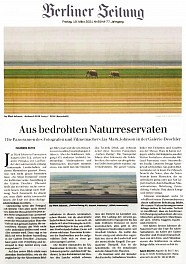Berliner Zeitung, Aus Bedrohten Naturreservaten
March 19, 2021 - Ingeborg Ruthe
Berlin Newspaper, Friday 19 March 2021
Jay Mark Johnson’s panoramas bend themselves around corners. They run like treadmills along the gallery walls—horizontal landscapes with mysterious attenuations—depicting events that cannot be precisely identified. The Californian artist calls his exhibition at Berlin’s Galerie Deschler “No Stone Unturned”. At first consideration, the title might sound hopeful, even encouraging, expressing the idea that one should leave no stone unturned in saving the earth from ecological collapse. But the label also suggests that mankind has already turned over every stone, that humankind has already usurped every place on the planet. Pristine locations on Earth no longer remain untouched. Everything has been destroyed. Looking over his exhibition, Johnson says: “Humans have taken over everything and destroyed it. We have turned every rock everywhere.”
At first glance, one experiences abstract striped pictures like those painted by the English op-art master Bridget Riley whose works irritate the viewers with visual shifts. But the Californian, born in 1955, who studied architecture and anthropology and who worked as a media activist and filmmaker, has meticulously staged something entirely different. He has captured not only an abstract, minimalist patterning of the terrain. He also conveys an environmental catastrophe, looming before us in slow motion, in a seemingly endless strip of expansive landscapes. In one of the largest panoramas, dust clouds from underground detonations are blasted upward and forward into a bullet-like avalanche.
These images were created in the US state of Kentucky (which means “in the field” in the Iroquois language). In remote mines near the town of Hazard, heavy mega-trucks churn dirt and debris up into the air. Johnson calls these bizarre panoramas Carbon Dating. Hauling payloads of rubble that were exploded up from the ground, the giant earthmovers cart away their materials to loading stations far away. All vegetation of the surrounding areas has been completely destroyed. Exactly what is being carried off by the convoy of parallel transporters cannot be seen. Everything in the endless horizontal expanse is hazed over by white-gray dust clouds,. Whatever is actually going on remains a mystery. It is as if the motif has only one strong message: Look, we have landscape and we have human intervention. It is permanent assault. We must decide what to do. Our choices will determine the future of the planet.
As a contrast to the Kentucky images, the artist presents photographs depicting brightly striped images with elephants and giraffes traversing the Maasai Mara in Kenya. He also shows what appears to be a 360-degree panorama from Zimbabwe of the Victoria Falls waterfall. The latter image conveys the force of nature par excellence. Every inch of the picture reads: Man needs nature, but nature does not need people who carelessly destroy everything—out of greed of necessity—through overexploitation, mass tourism, deforestation, urban sprawl, traffic, through wars and bitter poverty.
But Johnson doesn’t moralize. With his panorama camera, utilizing sophisticated exposure techniques, he creates images that call our norms of perception into question. He has modified the technology of his camera so that it continuously records movement...of the man-controlled machines that sow, harvest, dig, build...and destroy.
In the basement of Galerie Deschler, the exhibition presents documentary “making of” snapshots taken during the Californian’s photo and film excursions. They depict how, for years, Johnson has been touring the world’s nature reserves to produce these critical images and many others like them. The images prove just how serious he is.
Download Article (PDF)
